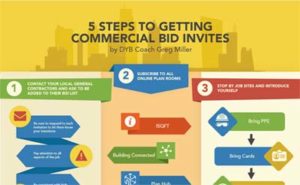
How to Bid Commercial Painting
Hello everyone, Greg here from DYB Coach.
5 Steps To Getting Commercial Bid Invites
Download the 5-Step Quick Reference Guide

Today I wanted to share with you what a typical commercial painting proposal looks like, and some of the things to look out for; the do’s and don’ts.
Let’s get started…
So, what you see here is a painting proposal for a job that we just recently did for our commercial painting company, and I am going to go through all the items on it and break down exactly what it needs to look like for you.
The top of the bid, you are going to see Painting Bid 09900, a commercial painting, finishes are described and limits yourself to that particular scope.
Just below that there, you are going to see the license information, so you are going to put that for your respective states, make sure you include that, this is your license to perform the work.
Here, below that is dated, and this is the date that we actually submit the proposal, that’s 1/1/19, then if we have made modifications to it, we put in parenthesis that it’s been updated.
And then next to that, or just below that, you will see; Attention, Construction Company, whatever the construction company is.
Be sure to include a specific estimator or somebody that has requested it for you, make sure to include their contact info there. And which job specifically is it regarding?
As we move on, below that, we like to list off very specifically, what the date of the drawings are, that we have on file.
So, for this job here, you’ll see that… I just added this in, job dated through 1/1/19, if there’s any modifications post your proposal sent to them, you can easily just refer back to your original proposal, and provide any additional pricing that is necessary.
Then below that, we have a little lined item here, to identify whether or not the job is a prevailing wage or Davis Bacon wage, and we are going to put no on that unless it is specifically specified.
And this could save your butt, if you ever get into a commercial situation, say for example you are bidding a government job where it is not clearly defined, and you are not able to submit additional pricing for it.
Just below that, we are going to get into our scope of work. So, for this job specifically, there are 12 items included, not a very big job, small burger franchise, something you guys might have in your home.
So, we have wood doors and frames, hollow metal doors and frames, interior wood running trim, which is a chair rail, and also baseboard.
Typically you don’t find that in a commercial job, but we specifically put it back here, caulking of field, painted door frames and wood running trim, if applicable.
Sometimes you don’t have to caulk things because of meeting up to another substrate. Caulking of an ACT ceiling grid and FRP to the wall.
So, that’s Back of House, that’s what BOH stands for, behind the kitchen wall, where all the cooking goes on, there’s a federal regulation for that now.
For kitchens, exposed ceiling, structure, and columns that was in the main dining area, the whole entire exposed ceiling was sprayed, as well as the ACT ductwork and the sprinkler piping, all those things, we make sure that we include that in there.
Then you have your standard Gypsum Walls, ceilings which are in the restrooms, Soffits, and Bulkheads, anywhere there is a transition of ceiling heights.
And we specifically excluded Drywaller’s work here, sometimes there is a little grey area with that, on jobs.
Then as we move on, we’ve got Wood Sidings, Bar Shelving, and Underside of Bar Counter, on this particular job, there was a kind of restored wood finish, kind of burn wood finish on the back.
We had to put a fireproofing on there, which was a very specific coating, and with a special… see here, it is specially coated with a class C fire coating.
And as we move on, we are moving to the exterior part of the job, its Dining Patio Guard railing, which is exactly what it sounds like, then we have exposed rooftop Gas Piping, typically where the gas runs from the meter to the unit.
Then we have some exterior touchup on this one, we weren’t really sure the extent that was going to be, so we highlighted that on here.
And then, on every single project, the way that we like to bid them is we add some touchup hours depending on the size of the job, so that if there are any damages by trades, they have some hours allotted, and they know that they are not going to get back charged, unless it exceeds a certain amount.
We’ve had great successes in the past, but on some jobs, people feel that it is difficult to appropriate the right amount of hours, depending on the job size, it is something that you might want to consider trying.
And just below that, you’ll see the total base bid, this is where we put our pricing, below that we’ll have some RFI’s, if there is a specific item that we are not certain about, maybe there is a color not listed, maybe there is a product not listed, we will be very specific about listing those items out individually.
If there is any type of additional pricing, sometimes they’ll ask for an alternate price on using a different product, or maybe they just want to delete something, so we’ll add those in below the RFI’s and we will get into our exclusions, which is very important.
You want to make sure that you include the things that you are not going to do.
For us, one of those things is, we don’t do fire caulking, acoustical ceilings, unless otherwise noted, caulking of pre-finished substrates, which could be your storefront windows.
A lot of times the window and soil will disappear after the job after they install on the exterior, but they never come back to caulk the interior.
So this can save you a lot of money and time depending on the size of the job.
We have touchup due to trade damages after the 8 hours, it is kind of like what I was talking about before.
We don’t include that in our bid, it’s impossible to quantify that, packing and pavement painting, so we are not doing any cap signs, we are not doing any lines in the parking lot, curbs, anything of that nature, concrete floor finishes and ceilings.
There were other trades doing that on this specific job, so we exclude that on our bid, you may want to include that on yours, you could simply just add that up into the scope of work.
We don’t paint any Laminate or FRP, Glass Film which is basically tints, it is done by somebody else, site-related painting, there are no civil plans on this job, because this particular job was a tenet improvement.
It was an existing building that was retrofitted for this specific restaurant, so anything that was not listed on the drawings, we do not anticipate.
They were replacing Awning Frames, we are going to assume that those are pre-finished, unless otherwise noted, interior galvanized pipe, framing, and metal screens.
So, standard, you don’t typically paint over galvanized metal unless it is a very specific kind of galvanized metal, so we exclude that. Exterior Scope, except Guard railing and Gas Piping.
So, below that, on our second page here is where our details are, about payment and things of that nature. So, for this particular project, we are going to include labor, equipment, and materials, taxes to perform the required work.
The proposal is good for 60 days, you want to make sure you date them, in case you come back to it a year later, and you may have a price increase, and your vendors typically have a duration of time that they are willing to honor pricing, and it is not generally past 60 days.
If they need a bond for this specific project, that’s something that you can include pricing, we are going to tell them that we are going to bill out mobilization, prior to the commencement of the job, and that doesn’t always happen on commercial construction, but it is in our contract.
All specified paint coats are installed prior to cabinet and fixtures, so that means that we get to get in there and do our finishes before the floors are done, things of that nature, because you know, it can get quite costly having to cover everything up in the middle of the job.
Any product that wasn’t available in bid documents were assumed that we have the discretion to choose those. Standard commercial practices is a 1-year warranty against defects in workmanship.
And we always put the caveat in there about the PDCA standards that can really save your butt if you ever get into a situation where there is an issue with the coating or somebody might have…
I am sure you guys have seen this, people break out the halogen lights and they are holding, one foot from the wall, microscope, looking at everything.
And also we have listed here, that we are not responsible for cleaning of substrates that become dirty due to improper site storage.
You might run into that with structural steel, where they lay that out in the yard, it gets covered in mud, they erect it and they expect us to go in there and just clean it off and paint it, that’s not something that we can anticipate, so we make sure that we include that.
And then just below that, we ask for a schedule, not on the smaller projects, you don’t generally get them, but we do ask for it, so that if they ever tell us that we have to work overtime to ensure protection of the guys on the site, we cover ourselves for that.
And below that, we have our additional work, we price them upfront, we tell them what our billable hour is, if there is going to be overtime, what it is, what our markup is for material, and also we let them know that we are not including per diem in that pricing.
So for traveling out of town, or any equipment that we need to rent, it’s not covered in that, so that would be basically a time and material situation if there is any additional work on sites.
Thank you guys for stopping in, just to recap what we talked about today, some of the dos and don’ts with commercial painting estimating, some things that you want to include on your proposals.
If you have any questions or comments, feel free to drop them below the video here or send me an email at greg@dybcoach.
Thanks, you guys can do this!

